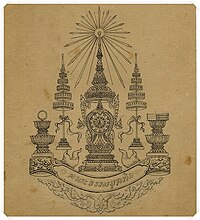
Back Thammayut-nikai German Dhammayuttika Nikaya Spanish Dhammayuttika Nikaya French Dhammajuttika rend Hungarian Dhammayuttika Nikāya ID ធម្មយុត្តិកនិកាយ Cambodian ဓမ္မယုတ္တိနိကာယ (မဟာယျေန်)၊ ဂိုဏ် MNW ဓမ္မယုတ္တိနိကာယ (မဟာရင်) ဂိုဏ်း Burmese Dhammayuttika Nikaya Dutch ธรรมยุติกนิกาย Thai
 | |
| Abbreviation | Dhammayut |
|---|---|
| Formation | 1833 |
| Founder | Vajirañāṇo Bhikkhu (later King Mongkut) |
| Type | Buddhist monastic order |
| Headquarters | Wat Bowonniwet Vihara, Phra Nakhon District, Bangkok, Thailand |
Superior general | Somdet Phra Ariyavongsagatanana IX (Incumbent since 2017) |

| Part of a series on |
| Theravāda Buddhism |
|---|
 |
| Buddhism |
Dhammayuttika Nikāya (Pali; Thai: ธรรมยุติกนิกาย; RTGS: Thammayuttika Nikai; Khmer: ធម្មយុត្តិកនិកាយ, Thômmôyŭttĕkâ Nĭkay), or Dhammayut Order[1] (Thai: คณะธรรมยุต), is an order of Theravada Buddhist bhikkhus (monks) in Thailand, Cambodia, and Burma, with significant branches in the Western world. Its name is derived from Pali dhamma ("teachings of the Buddha") + yutti (in accordance with) + ka (group).
The order began in Thailand as a reform movement led by a prince who would later become King Mongkut of Siam, before also spreading to Cambodia and Burma. Initially, King Mongkut was frustrated because he could not find monks who understood the original teachings of the Buddha and truly adhered to the rules of the monks. This happened because of the syncretism of Buddhism with Thai folk religion. Consequently, King Mongkut emphasized the use of the Pali Canon as the primary authority for monastic practices, and sought to eliminate all of the syncretic elements. The movement became formally recognized as its own monastic order by the Thai government in 1902, with any Thai Theravada bhikkhus not within the order being referred to as part of the Maha Nikaya order.
The Dhammayuttika Nikaya plays a significant political role in Thailand. The order has historically been favored by the Thai government and monarchy, with the order holding the majority of all royal monastic titles in Thailand and most of the Supreme Patriarchs (the head of the Thai monastic community) since its founding having come from the Dhammayuttika Nikaya, despite the order making up less than ten percent of all bhikkhus in Thailand.